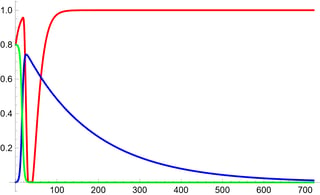I have the following coupled non-linear ODE system, which describes a biological system:
$$\frac{dp}{dt} = -\gamma p f,$$ $$\frac{df}{dt} = -c f + \gamma p f,$$$$ \begin{cases} \dfrac{dp}{dt} = -\gamma p f,\\ \\ \dfrac{df}{dt} = -c f + \gamma p f,\\ \\ \dfrac{dT}{dt} = \left( 1 - \dfrac{k}{T} \right) \left\{ b (1 - T) \dfrac{r^n}{f^n + r^n} - m \dfrac{f^n}{f^n + r^n} \right\}, \end{cases} $$ $$\frac{dT}{dt} = \left( 1 - \frac{k}{T} \right) \left\{ b (1 - T) \frac{r^n}{f^n + r^n} - m \frac{f^n}{f^n + r^n} \right\},$$
wherewhere the parameters are: $\gamma = 0.5432$, $c = 0.006$, $k = 0.0026$, $b = 0.0885$, $n = 14.9832$, $r = 0.8265$, and $m = 0.9780$.
The system has two equilibria: $(f \to 0, T \to k)$ and $(f \to 0, T \to 1)$, regardless of the value of $p$. I don't know if such systems have a name in the mathematical literature, but I call it degenerate.
My questionMy question is: How can one investigate the stability of these two equilibria? (Since $p$ can be anything, it isn't clear to me how one can calculate the Jacobian.)
If we simulate the system with Mathematica for some initial conditions, we have:
s = NDSolve[{p'[t] == -gamma p[t] f[t], f'[t] == -c f[t] + gamma p[t] f[t],
T'[t] == b (1 - T[t]) (r^n/(f[t]^n + r^n)) (1 - 0.0026/T[t]) - m (f[t]^n/(f[t]^n + r^n)) (1 - 0.0026/T[t]), p[0] == p0, f[0] == 0.001, T[0] == T0} /. {gamma -> 0.5432, c -> 0.006 , b -> 0.0885,
m -> 0.9780, r -> 0.8265, n -> 14.9832, p0 -> 0.8, T0 -> 0.8}, {p, f, T}, {t, 0, 720}];
p2 = Plot[Evaluate[{T[t], f[t], p[t]} /. s], {t, 0, 720}, PlotStyle -> {Red, Blue, Green}, AxesOrigin -> {-1, 0}, PlotRange -> All]
The above plot suggests that $(f \to 0, T \to 1)$ could be the stable equilibrium as the solution is converging to it. Is it safe to conclude that $(f \to 0, T \to k)$ is the unstable one?

